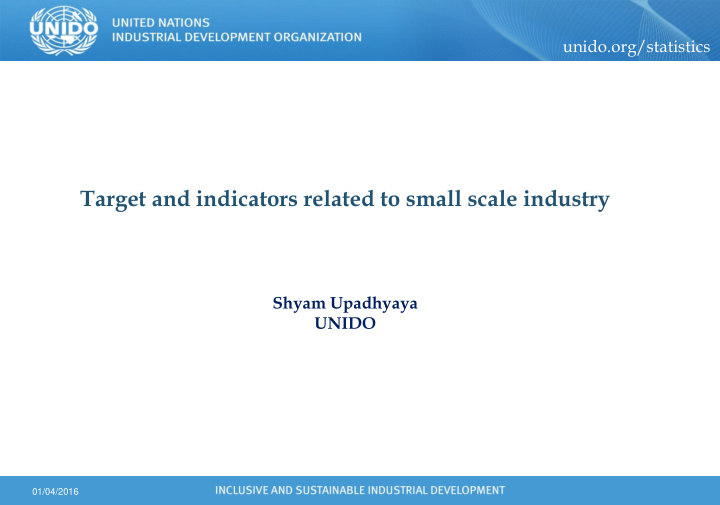



unido.org/statistics Target and indicators related to small scale industry Shyam Upadhyaya UNIDO 01/04/2016
unido.org/statistics Target and indicators 9.3 Target Selected indicators Computation 9.3 Increase the access of 9.3.1 Proportion of small-scale industrial and small-scale industries other enterprises, in in total industry value particular in developing added countries, to financial services, including 9.3.2 Proportion of affordable credit, and small-scale industries their integration into with a loan or line of value chains and markets credit 2
unido.org/statistics Data and methodology - Small enterprises are independent unincorporated firms with limited employment and assets. - Data on small scale industries are widely available at national level, however there is no international data collection programme. - Data reported to UNIDO represent either national total or estimates for enterprises above the cut-off size (mostly 10 or more persons engaged). - For 9.3 indicators it is necessary that data are reported by size class 3
unido.org/statistics Size class definitions IRIS OECD/Eurostat 1-9 Micro 1- 9 Employment based Small 10-49 10-19 size classes Medium 50-249 (easy to derive from a 20-49 Large 250 + statistical register ) 50-249 250+ Policy or legislation based groups (examples) A small enterprise is the one with less than 25 employees EU: A small enterprise is and less than 20 million NC in assets defined as an enterprise which employs fewer than 50 Small enterprises are defined as enterprises employing a persons and whose annual maximum 50 people; the value of assets excluding land, turnover and/or annual buildings and working capital is less than NC 50 million; balance sheet total does not annual turn over is between NC 10 – 50 mil, which is the exceed EUR 10 million tax bracket for 1% business tax on annual turn over. 4
unido.org/statistics Working group or task team for size class definition • For the purpose of international comparability, it might be necessary that a uniform definition of Small is agreed for global reporting purpose. • Definition does not imply any suggestion with respect to existing national, supra-national or regional definitions • Employment based size-class categories are preferred to value based thresholds due to the differences arising from inflation, currency exchange and other market fluctuations. 5
unido.org/statistics Data collection and capacity building plan • Standard industrial survey instruments will be utilized to collect the data from smaller enterprises. • UNIDO is revising its general industrial survey questionnaire in order to include the new data items related to SDG indicators. In parallel, applications for data processing and storage are being developed Overall capacity building programme in industrial statistics will address • the questions related to size-class data too • We seek cooperation and synergy with UNCDF, OECD and the World Bank (enterprise survey team) • Decision on a uniform size-class definition would help preparatory work on data collection and compilation 6
Recommend
More recommend